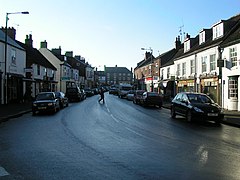Boroughbridge
| Boroughbridge | |
|---|---|
 Boroughbridge high street | |
| Population | 3,210 |
| OS grid reference | SE393668 |
| District | |
| Shire county | |
| Region | |
| Country | England |
| Sovereign state | United Kingdom |
| Post town | YORK |
| Postcode district | YO51 |
| Dialling code | 01423 |
| Police | North Yorkshire |
| Fire | North Yorkshire |
| Ambulance | Yorkshire |
| UK Parliament | |
Boroughbridge is a small town 13 miles (21 km) northwest of York in North Yorkshire in England. Until its bypass was built, it was on the main A1 road from London to Edinburgh. The A1 crosses the River Ure here.
History
A line of three menhirs, or standing stones, known as The Devil's Arrows, believed to have been erected in the Bronze Age, can be found on the outskirts of Boroughbridge, just by the side of the A1. The tallest stone is 6.8 metres in height.
In 1322, the Battle of Boroughbridge took place as King Edward II overpowered Thomas Earl Of Lancaster, bringing about the end of Edward II's retaliation against those who had opposed him in the Despenser War of 1320-1321.
Boroughbridge was a parliamentary borough from medieval times, electing two Members of Parliament to the unreformed Commons. It had a "burgage" franchise, meaning that the right to vote was tied to ownership of certain pieces of property in the borough, and it had less than 100 qualified voters by the time it was abolished in the Reform Act of 1832: It was a pocket borough entirely under the control of the Dukes of Newcastle. Augustus FitzRoy, who was later Prime Minister as the 3rd Duke of Grafton, was elected MP for Boroughbridge in 1756; however, he never sat for the borough as he preferred to represent Bury St Edmunds where he had also been elected.
In the days of stagecoaches, Boroughbridge was an important stage, thanks to its position on the Great North Road midway between London and Edinburgh. An advertisement in the Edinburgh Courant for 1754 reads:
The Edinburgh Stage-coach, for the better accommodation of passengers, will be altered to a New Genteel Two-end Glass Coach Machine, being on steel springs, exceeding light and easy, to go in ten days in Summer and twelve in Winter; to set out the first Tuesday in March, and continue it, from Hosea Eastgate's, the Coach and Horses, in Dean-Street, Soho, London; and from John Somerville's, in the Canongate, Edinburgh, every other Tuesday, and meet at Burrow-Bridge on Saturday night, and set out from thence on Monday morning, and get to London and Edinburgh on Friday. In Winter, to set out from London to Edinburgh every other (alternate) Monday morning, and to go to Burrowbridge on Saturday night; and to set out from thence on Monday morning, and get to London and Edinburgh on Saturday night. Passengers to pay as usual. Performed, if God permits, by your dutiful servant HOSEA EASTGATE.
In 1945 the A1 bridge over the River Ure collapsed under the weight of a heavy transport vehicle carrying an 80-ton steel mill roll housing from Sheffield to Falkirk. That interrupted a main transport route only for a short while, the Army installing a Bailey bridge until repairs were completed.
Present day
Boroughbridge has both a primary school and a high school. Boroughbridge High School specializes in performing arts and has a library, computer rooms and a drama studio. It celebrated its 25th anniversary in the summer of 2007. .
Close to Boroughbridge is the village of Aldborough, once the site of the Roman settlement Isurium Brigantum (SE406664). There is a small museum.
Location grid
